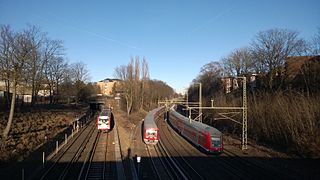Related Research Articles

A Regierungsbezirk means "governmental district" and is a type of administrative division in Germany. Currently, four of sixteen Bundesländer are split into Regierungsbezirke. Beneath these are rural and urban districts.
Neustadt may refer to:
The German Federal Coast Guard is a civilian law enforcement organisation whose primary missions are border protection, maritime environmental protection, shipping safety, fishery protection and customs enforcement. The Küstenwache is an association of several federal agencies, not a single entity like the United States Coast Guard.

Altstadt is the German language word for "old town", and generally refers to the historical town or city centre within the old town or city wall, in contrast to younger suburbs outside. Neustadt, the logical opposite of Altstadt, mostly stands for a part of the "Altstadt" in modern sense, sometimes only a few years younger than the oldest part, e. g. a late medieval enlargement.
The Bundesgartenschau is a biennial federal horticulture show in Germany. It also covers topics like landscaping. Taking place in different cities, the location changes in a two-year cycle.
The German Customs Investigation Bureau in Cologne and its investigation offices are federal agencies that fall under the German Finance Ministry. The ZKA coordinates customs investigations nationwide in particular monitoring foreign trade, uncovering violations of EU market regulations, illegal technology exports, subsidy fraud in the agricultural sector, drug trafficking and money laundering.

The approximately 5,400 railway stations in Germany that are owned and operated by the Deutsche Bahn subsidiary DB Station&Service are divided into seven categories, denoting the service level available at the station.

Rapid transit in Germany consists of four U-Bahn systems and fourteen S-Bahn systems. The U-Bahn commonly understood to stand for Untergrundbahn are conventional rapid transit systems that run mostly underground, while the S-Bahn or Stadtschnellbahn are commuter rail services, that may run underground in the city center and have metro-like characteristics in Munich, Hamburg and Berlin which they only have to a lesser extent in other cities. There are also over a dozen premetro or Stadtbahn systems that are rapid transit in the city center and light rail outside.
In Germany and Austria, the running of railway services for a railway administration or the regional network of a large railway company was devolved to railway divisions, variously known as Eisenbahndirektionen (ED), Bundesbahndirektionen (BD) or Reichsbahndirektionen (RBD/Rbd). Their organisation was determined by the railway company concerned or by the state railway and, in the German-speaking lands at least, they formed the intermediate authorities and regional management organisations within the state railway administration's hierarchy. On the formation of the Deutsche Bahn AG in 1994 the system of railway divisions (Eisenbahndirektionen) in Germany was discontinued and their tasks were transferred to new "business areas".

The Neustadt–Wissembourg railway, also called the Pfälzische Maximiliansbahn, Maximiliansbahn or just the Maxbahn - is a railway line in southwestern Germany that runs from Neustadt an der Weinstrasse to Wissembourg in Alsace, France. The Palatine Maximilian Railway also included a branch from Winden via Wörth and the Maxaubahn to Karlsruhe.

This article shows a list of railway stations in Germany. The list is subdivided per federal state. Due to the number of railway stations it shows a selection of the principal stations and links to related state articles. Where there are 2 or more passenger stations in a large town or city, the most important is often designated by the Deutsche Bahn as the Hauptbahnhof, of which there are 122 in total.

The Gesellschaft für deutsche Sprache, or GfdS, is Germany's most important government-sponsored language society. Its headquarters are in Wiesbaden. Re-founded shortly after the Second World War in 1947, the GfdS is politically independent and the declared successor of the Allgemeiner Deutscher Sprachverein, the General Association for the German Language, which had been founded in 1885 in Brunswick. Its aim is to research and cultivate the German language; to critically evaluate the current German language change; and to give recommendations concerning the current usage of German.

Intercity (IC) is the second-highest train classification in Germany, after the Intercity Express (ICE). Intercity services are locomotive-hauled express trains, usually over long-distances. There are Intercity routes throughout Germany and routes generally operate every other hour, with multiple routes giving a more frequent service on core routes. Intercity services are operated by the DB Fernverkehr division of Deutsche Bahn, Germany’s national railway.

The PSD Bankengruppe is a German cooperative banking group consisting of 14 autonomous and independent financial institutions. The business model of the PSD banks is a combination of regional direct and affiliated bank. It provides retail banking services via internet, telephone, e-mail, mail and fax or at local branches, it only provides services to retail clients and does not offer banking to self-employed and businesses.
References
- ↑ "Structure reform Press-Release (German)". Zoll.de. Archived from the original on 2015-07-22. Retrieved 2015-07-21.
- ↑ e.zoll-info 9/2014 and e.zoll-info 4/2015